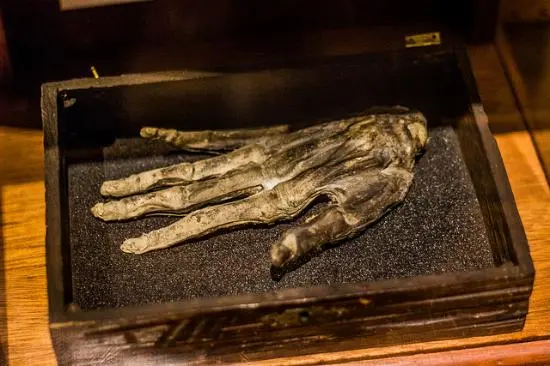The Hand of Glory, an intriguing artifact steeped in legend and mystery, takes center stage at the Whitby Museum, captivating visitors with its eerie allure. Nestled amidst the picturesque coastal town of Whitby in North Yorkshire, England, the museum offers a fascinating journey through history, art, and folklore. Yet, it is the Hand of Glory that often steals the spotlight, drawing curious onlookers into its shadowy realm of superstition and myth.
Stepping into the Whitby Museum, one is immediately struck by its old-world charm and intimate atmosphere. Housed within a historic building, the museum exudes an aura of antiquity, its walls adorned with an eclectic array of artifacts and curiosities. From fossilized remains to maritime memorabilia, each exhibit tells a story, weaving together the rich tapestry of Whitby’s past.
Among the museum’s many treasures, the Hand of Glory stands out as a relic shrouded in legend. Consisting of a mummified human hand, typically that of a hanged criminal, the Hand of Glory was believed to possess magical properties in medieval folklore. According to tradition, the hand, when combined with certain incantations and rituals, could render its bearer invisible or immobilize unsuspecting victims.
The origins of the Hand of Glory are murky, with tales of its creation varying across different cultures and time periods. Some accounts trace its roots to ancient Mesopotamia, where severed hands were used in rituals to invoke protection or curse enemies. In European folklore, the Hand of Glory gained prominence during the Middle Ages, becoming associated with witchcraft and the occult.
One of the most enduring legends surrounding the Hand of Glory involves its use as a tool for burglary. According to folklore, thieves would fashion candles from the fat of a hanged man, using the fingers of the Hand of Glory as candlesticks. These enchanted candles were said to have the power to render occupants of a house unconscious, allowing the thieves to plunder without resistance.
The Hand of Glory on display at the Whitby Museum is a testament to the enduring fascination with this macabre artifact. Encased in a glass cabinet, the shriveled hand invokes a sense of awe and trepidation in equal measure. Its withered fingers, frozen in a grotesque gesture, seem to beckon visitors into a realm of darkness and superstition.
Yet, beyond its morbid allure, the Hand of Glory serves as a window into the beliefs and fears of bygone eras. In an age rife with uncertainty and peril, people turned to talismans and charms for protection against malevolent forces. The Hand of Glory, with its purported ability to bestow invisibility or paralyze enemies, offered a glimmer of hope in a world fraught with danger.
As visitors gaze upon the Hand of Glory at the Whitby Museum, they are transported back in time to an era of superstition and folklore. Whether viewed through the lens of curiosity or skepticism, the Hand of Glory continues to captivate imaginations and fuel the fires of speculation. And amidst the hushed whispers and whispered legends, one cannot help but wonder: What secrets does this ancient relic hold, and what mysteries lie hidden within its grasp?



